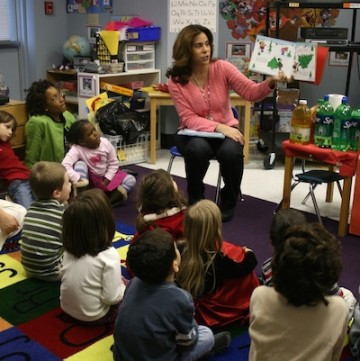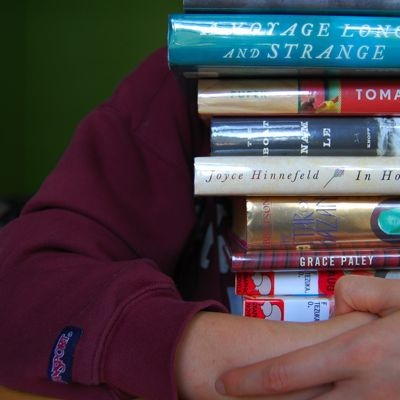Portland Teachers Balking at Special Education Redesign
Thursday, June 11, 2015

“It’s more about a philosophical shift in the way that we view, and our expectations of, students who experience a disability,” said Mary Pearson, special education director. “The idea is we want to move more toward inclusive practices so that the majority of students are receiving their education in a regular education setting.”
But classroom teachers are concerned about receiving enough support to help students with special needs, especially behavioral issues, since the change could eventually move many students previously in behavioral classrooms into regular classrooms.
Student and staff safety are a huge concern, said Gwen Sullivan, president of the Portland Teacher’s Association. “Everyone is really having a hard time with (the special ed redesign).”
Sullivan is concerned that about the district getting rid of the behavior classrooms as a part of its Reach 2020 plan. Without middle ground spaces like the behavior classrooms, Sullivan said the options are either the regular classroom or an even more restrictive environment.

The majority of students with disabilities do not have a cognitive impairment, said Pearson. “They really have the ability to access general education curriculum, (though) they might need it in a different manner.”
Scope of Special Education Needs is Significant
Approximately 6,900 students of the district’s total 48,500 are receiving special education services, but not enough of them are succeeding academically. Of third graders in special education programs, only 53 percent met state benchmarks, while the state would like to see at least 69 percent hit achievement targets. Even fewer graduate from high school—31 percent of students with disabilities receive a diploma within four years. The state aims to see 67 percent of students with disabilities graduating.
But one big reason for the district’s attention to special ed is the growing concern over the disproportionate number of black students with disabilities. Currently, 25 percent of behavior classroom students are black, while the total black population in the district is only 10.7 percent. Black students with disabilities are also five times more likely to be expelled for more than 10 days during a school year.
The U.S. Department of Education (USDE) has been concerned about the disproportionate number of minority students in special education—an issue in which Portland is not alone. While states are required to set and monitor their own guidelines of what is “disproportional,” the USDE is planning to issue additional guidance on how federal funding can be used to address the issue some time this year.
In the meantime, PPS has been sanctioned for two years by the Oregon Department of Education (ODE) for disparity in exclusionary discipline of special education students of color during the 2012-2013 school year, which means that they must set aside 15 percent of federal special education funding to address intervention services.
Pearson said that the district has cut its expulsion of African American students with disabilities by half since the sanction but that according to state monitoring, it may not be enough since number of expulsions also decreased for white students during the same period. “We are making progress in that area. We are not there yet and we realize that this is still a problem,” said Pearson.
As a result, the district is taking two strategies, including applying funding to intervening before students are removed from general education as well as restorative justice, which aims to reduce expulsions and find other ways to address behavioral issues.
“We were already moving in that direction,” said Pearson. “For us it wasn’t like money was taken away from us but… it’s actually a good thing.”
In Sullivan’s view, however, the move toward fewer disciplinary options is creating a less safe environment. One of Superintendent Carole Smith’s top priorities this year is to cut our exclusionary discipline in half and close the gap between students of color and white students by half.
But the policy, which attempts to avoid expulsion, coupled with a new state law passed last year that restricts teachers from restraining students unless there is an immanent threat, gives teachers little disciplinary options in high-risk situations.
Difficult Challenges
This year was a hard year for some teachers, however, as the district took first steps by holding off on making any placements of students in grades K-2 into behavior classrooms.
As a result some kindergarten teachers have faced difficult behavioral issues with little support, said Sullivan. One student regularly bites and scratches a teacher, she said. “It got to the point where there was some sort of shuffle and kid pushes her down and she got a concussion.”
“We had another one where kiddo (a kindergartener) stripped down to nothing and got on ledge,” said Sullivan.
When situations like this are happening, teachers aren’t feeling supported by the policies or programs. “The kids that are actually doing some of these things, they’re not getting the help they need either,” she said.

Pearson said the decision to end placement of K-2 students in behavior rooms was a “moral imperative.” “We were making a decision about a kindergartener that could affect whether or not they will graduate from high school,” she said. “That time period in a child’s life is really important. It’s really important that they don’t miss rigorous instruction and that we learn how to support our young students.”
Only about 6 percent of students who do enter a behavior classroom in K-2 ever go back to the regular classroom, she said. “It’s very likely they are not going to be academically equipped to engage in the rigor of high school.”
Other shifts in special education services outlined in the Reach 2020 are currently in flux. Over the last few months, administrators have been reaching out to special ed advisory groups, parents and principals, and there have already been two community forums.
Pearson said that major program decisions have yet to be made. “Staff really need to build their skills and understanding before we can move to big program shifts,” she said.
Next year, the district will also launch pilot schools that will be demonstration sites for co-teaching and inclusive practices. One example of this kind of inclusive model will be co-teaching between the regular classroom teacher and learning specialists and speech language pathologists. Another part of it is “increasing the capacity of teachers and staff to reach a wider range of learner,” said Pearson. “This is not solely a special education initiative. This is changing the way we are educating all students.”
Likely this will include more consultation between teachers and school psychologists, who can advise on managing behavior and working with students with disabilities, cultural or linguistic barriers and students who socioeconomic background is affecting their learning.
Pearson said that the district should have enough special education funding to allow for this transition, though part of the challenge will be in appropriately reallocating funding.
Related Slideshow: 9 Challenges Facing Portland Public Schools
Aiming to lower expulsion rates, especially for students of color, and raising high school graduation rates are among Portland Public Schools’ top priorities. See what other challenges the schools are facing here.
Related Articles
- Some Oregon Industries Hurt By Push For Higher Education
- The Top 100 High Schools in Oregon
- The Link Between Schools and Property Values in Oregon
- Shooter Identifed In Washington’s Marysville School Shooting
- Voters Pass Portland School District Levy Renewal, Measure 26-161
- Vancouver Public Schools Earn Grant Funding for School Behavioral Services
- BREAKING: North Portland High School Shooting: 3 shot Outside School, Suspect Fled on Foot
- Do School Rankings Matter?
- College Counseling: Great Schools for Kids Who Love Learning Languages
- College Counseling: Great Schools still accepting applications for Fall 2015
- Who’s Hot and Who’s Not in Oregon Politics: Grant High School, Lazy Candidates, Chuck Riley
- Why I Love My Diverse and Accepting School
- UPDATED: Parent Files Federal Lawsuit Against Portland Public Schools
- Willamina Middle School Teacher Arrested for Assaulting 6 Year Old Child
- Why Oregon Ranks 36th for School Funding
- Why I Teach: A Portland-Area High School Teacher Reflects
- UPDATED: Portland Police Make Arrest in High School Shooting Case
- Teachers Union Wants Schools to Boycott High Stakes Tests
- Storm Hits East Coast and Epic ‘School is Closed’ Video Goes Viral
- SMART Seeks Volunteers for the 2014-15 School Year
- Portland’s Charter Schools Whiter Than Its Public Schools
- Portland High School Shooting: Love Your Kids, Give Them A Hug, Mayor Says
- Portland High School Shooting: Ceasfire Oregon to Hold Gunfire Violence Call to Action TONIGHT
- Pedestrian Injured After Being Struck, Pinned Under School Bus
- Portland High School Shooting: Third Suspect Arrested
- Portland High Schoolers Study: Media Saturation Better for Multitasking
- Portland Waldorf School Hosts Benefit with Storm Large
- Portland Student Threatens to Burn Down High School
- Portland Metro’s Top High Schools
- Shiny, Happy Kindergarteners: Five Tips for Your Child’s First Day of School
- School Board Candidate Falsely Claims Endorsement
- Scene of the Rosemary Anderson High School Shooting in North Portland
- Rex Burkholder: Restoring Oregon’s Outdoor School Tradition
- Ranking of Student Diversity in Pac-12 Schools
- School Bugs: 5 Ways to Boost Your Family’s Health During the School Year
- School District Cancels Board Meeting Amid Calls To Discipline Administrators
- See the List of Portland Metro Top High Schools 2014
- See Oregon’s Top 100 High Schools
- Scott Bruun: A School Week and Its Discontents
- Public School Teachers And Their PR Problem
- Who’s Hot and Who’s Not in Oregon Politics: The Race for Mayor, Education, Ducks
- Scott Bruun: Education, Priorities, and the Governor’s Budget
- National Spokesperson for Sex Education Coming to Portland
- PSU To Build New Education Center Shared with OHSU






















 Delivered Free Every
Delivered Free Every
Follow us on Pinterest Google + Facebook Twitter See It Read It